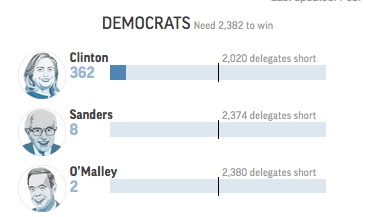The results in Iowa's presidential caucuses on Monday showed U.S. Sen. Ted Cruz of Texas beating billionaire businessman Donald Trump in the Republican contest, 28 percent to 24 percent -- an outcome that was contrary to poll after poll that showed the business mogul winning.
RELATED ARTICLES
http://www.arkansas…">Energized in Iowa, cast moves to N.H. face-offshttp://www.arkansas…">Huckabee exit shuffles deck for his backers in state
In the Democratic contest, the virtual tie between Hillary Clinton and Bernie Sanders was close for both the former secretary of state and pollsters who showed her with a narrow but steady lead heading into the caucuses.
The results underscored an evolving polling industry that has been battered in recent months by inaccurate readings of public sentiment.
On Monday night, Iowans defied expectations by attending caucuses in unprecedented numbers and handing Cruz a victory. Those misfires have raised doubts about the validity of polling at time of technological and social shifts even as political and business professionals increasingly rely on surveys and the data they collect.
Most pre-caucus polls showed Cruz within striking distance of winning and a tight Clinton-Sanders race but with Clinton coming out ahead. In the final Bloomberg Politics/Des Moines Register Iowa Poll before the caucuses, conducted Jan. 26 through Friday, Clinton held a 3 percentage point advantage over Sanders, while Trump led Cruz by 5 points. Both results on Monday night were within the margin of error.
The Cruz victory is just the second time since 1988 that the Iowa Poll, conducted by Selzer & Co., has incorrectly picked either the Democratic or Republican caucus winner in Iowa. The other exception was Republican Rick Santorum's 34-vote victory in 2012 over Mitt Romney. Selzer didn't conduct the poll in 1992.
J. Ann Selzer, president of Selzer & Co., said that while her final poll projected a victory for Trump, all of the variables that favored Cruz came together.
"We knew to look at evangelicals, and we tested it at 60 percent" of the Republican electorate, Selzer said. In the end, 64 percent of caucusgoers were evangelical or born again, according to a CNN entrance poll, giving Cruz important momentum.
"We always thought, and we certainly heard about, the ground game," Selzer said. "You can be for Trump, but if you don't show up, it doesn't matter."
The Bloomberg Politics/Des Moines Register Iowa Poll was in line with the average of eight polls compiled by RealClearPolitics, which showed Trump with a 4.7 point advantage heading into caucus day, and Clinton with a 4 point lead. The polls included in the average, though, showed the volatility and uncertainty of measuring voter intentions. The results ranged from an 11-point lead for Clinton in a Gravis Marketing survey to a 3-point edge for Sanders in a Quinnipiac University poll.
Rapid social and technological changes -- from the abandonment of landline phones to changing demographics -- have battered the polling industry globally with missed trends and sentiments. The degree of difficulty only increased in Iowa, where caucus structures, a history of low turnout and this year's wide field of candidates combined to inject confusion.
In caucus rooms, voters heard from neighbors and friends, raising the possibility of last-minute switches in loyalty for a candidate.
"These are people you know from the neighborhood, people you might respect, and that may sway your vote," said Timothy Hagle, a professor of political science at the University of Iowa. "Those last-minute changes make a difference, particularly if you have a really close race."
Turnout in Iowa is low compared to a primary or general election, increasing the odds of an off-base poll result. In 2012, 121,503 Republicans -- 19.7 percent of the state's 614,913 registered GOP voters -- cast a ballot. In 2008, a banner year for participation thanks to enthusiastic support for Barack Obama, just 23.3 percent of registered Democrats participated. But on Monday, Iowa Republicans turned out in record numbers.
Cruz's surprise victory was actually in line with some past polling misses. Polls conducted by the Register in 1988, 1996, and 2012 all significantly underestimated the candidate who would earn the backing of evangelical voters -- the very group that appeared to have pushed the senator to victory.
A week ago, GOP runner Marco Rubio's RealClearPolitics average was just 12.2 percentage points, before spiking to 16.9 percent hours before the caucuses, suggesting the Florida senator was primed for a surprise. He finished Monday with 23 percent -- trailing Trump by 1 percentage point, even though earlier polls had shown him behind the real estate mogul by double digits.
The Democratic side featured a smaller field but similarly difficult-to-quantify variables. Young voters drove Sanders' support, but the 18-to-34 year-old demographic has long been unreliable when it comes to showing up to vote.
Better methods "would require more time, and more money," said Mike Traugott, a political scientist at the University of Michigan who has advised Gallup on its polling methods. "The news organizations are not inclined to pay for that."
Monday's results mean pollsters are likely in for a fresh round of criticism over the reliability of polls that could further erode confidence in their survey methods.
"Pollsters need models, and sometimes the models they use don't work any longer," said Traugott, who has served as president of the World Association for Public Opinion Research.
A Section on 02/03/2016

